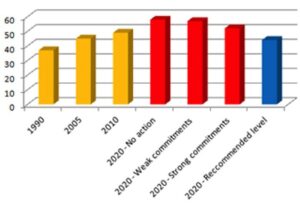 On Tuesday the United Nations World Meteorological Organization (WMO) reported in its Greenhouse Gas Bulletin that the volume of atmospheric greenhouse gases hit a new record in 2011. Carbon dioxide, the principal greenhouse gas, reached a level of 390.9 parts per million (ppm) in 2011, or 140 percent of pre-industrial levels.
On Tuesday the United Nations World Meteorological Organization (WMO) reported in its Greenhouse Gas Bulletin that the volume of atmospheric greenhouse gases hit a new record in 2011. Carbon dioxide, the principal greenhouse gas, reached a level of 390.9 parts per million (ppm) in 2011, or 140 percent of pre-industrial levels.
The WMO estimates that since 1750 about 413 billion tons – or 375 billion metric tons – of carbon has been released into the atmosphere from human activity, primarily from burning fossil fuels, but also from deforestation, land-use patterns, and modern large-scale agricultural practices. About half of this carbon released since then remains in the atmosphere, much of it lingering for centuries.
The impact of the accelerating emissions currently measured won’t be seen for years or decades, and the growing signs of global climate disruption (global warming) we now see are the consequence of emissions from years and decades ago. While forests and oceans have historically acted as a carbon sink, sponging up a large portion of this added carbon and helping keep the atmosphere in balance, there are growing signs that these natural carbon sinks are now increasingly pushed to their limits.
“Until now, carbon sinks have absorbed nearly half of the carbon dioxide humans emitted in the atmosphere, but this will not necessarily continue in the future,” WMO Secretary-General Michel Jarraud said in a statement. “We have already seen that the oceans are becoming more acidic as a result of the carbon dioxide uptake, with potential repercussions for the underwater food chain and coral reefs. There are many additional interactions between greenhouse gases, Earth’s biosphere and oceans, and we need to boost our monitoring capability and scientific knowledge in order to better understand these.”
According to the National Oceanic and Atmospheric Administration (NOAA) the “radiative forcing,” or the amount of warming effect caused by the trapped heat from greenhouse gases, shot up by 30 percent from 1990 to 2011. Carbon dioxide is responsible for about 80 percent of the increase, but other greenhouse gases such as methane (CH4) and nitrous oxide (N2O) also play an important role.
UNEP report: World is “Stepping on the Gas” in the wrong direction
In its Emissions Gap Report 2012 the United Nations Environment Programme states that even if countries adhere to their most stringent aspirational targets to reduce greenhouse gas emissions, the world will still overshoot by 8 gigatons of CO2 equivalent the 44 gigaton limit scientists say must be met by 2020 to avert runaway global warming. This is in contrast to last year’s report when the gap was “only” 6 gigatons over the 2020 target
“We are actively moving in the wrong direction,” said U.N. Undersecretary-General and UNEP Executive Director Achim Steiner, speaking at the report’s release in London. “In terms of emissions, the world has already broken the speed limit – now it appears to be putting its foot on the gas pedal, even though we know there is a T-junction ahead.”
The upcoming UNFCC COP18 Climate Conference, running from November 26 through December 7 in Doha, Qatar, comes on the heals of the UNEP report. As in the past UNEP is calling for nations to go “above and beyond” their current commitments as they negotiate international climate targets, pointing to a broad range of existing policy options that, if scaled up, could “close the emissions gap by as much as 17 gigatons,”according the UNEP report.
“Given our current trajectory,” says Steiner, “an underlying narrative may well emerge that we cannot achieve our 2-degree [Celsius] pathway goal by 2020, but I believe this report challenges that idea. For those who do not believe that radical changes are possible, we have seen in the last five to 10 years exceptional examples in achieving the transformative changes we are looking for,” he added.
Among those policy action Steiner sees as possibly bringing the transformative change needed are the successful implementation of feed-in tariffs, efficiency standards, and carbon accounting schemes, to name a few. Many of these policy actions are motivated as much by domestic as international concerns, Steiner says, and are key to a continued acceleration of emissions reductions.
“At a time when there’s a huge disconnect between the evidence of climate change and the inaction on the part of governments, identifying the problem is not enough,”said Keya Chatterjee, deputy director of the climate change program at the World Wildlife Fund. “We’ve got to focus on the potential that’s out there to reduce emissions.”



